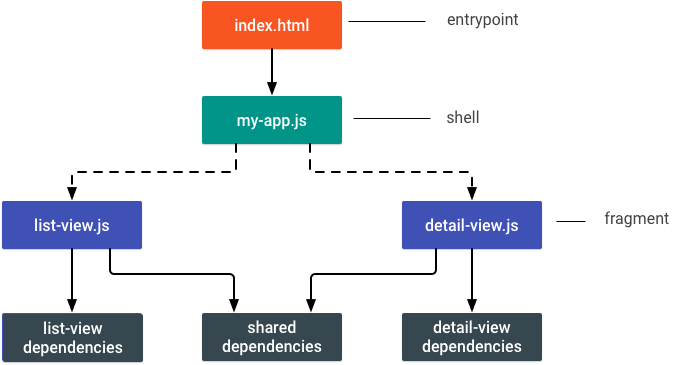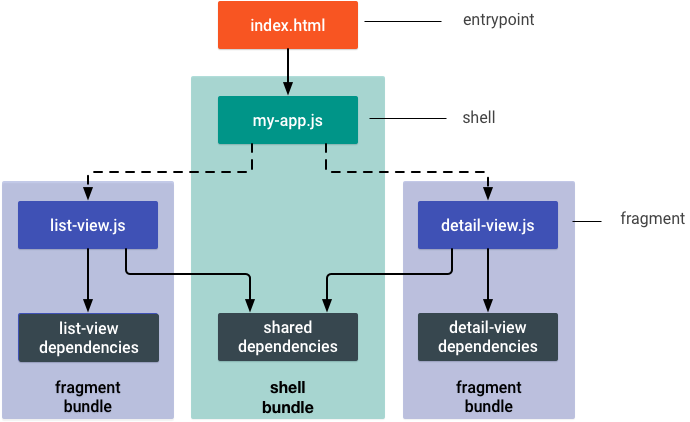To optimize delivery, the Toolbox uses the PRPL pattern, which stands for:
- Push critical resources for the initial route.
- Render initial route.
- Pre-cache remaining routes.
- Lazy-load and create remaining routes on demand.
To do this, the server needs to be able to identify the resources required by each of the app's routes. Instead of bundling the resources into a single unit for download, it uses HTTP2 push to deliver the individual resources needed to render the requested route.
The server and service worker together work to precache the resources for the inactive routes.
When the user switches routes, the app lazy-loads any required resources that haven't been cached yet, and creates the required views.
App structure
Currently, the Polymer CLI and reference server support a single-page app (SPA) with the following structure:
-
The main entrypoint of the application which is served from every valid route. This file should be very small, since it will be served from different URLs therefore be cached multiple times. All resource URLs in the entrypoint need to be absolute, since it may be served from non-top-level URLs.
-
The shell or app-shell, which includes the top-level app logic, router, and so on.
-
Lazily loaded fragments of the app. A fragment can represent the code for a particular view, or other code that can be loaded lazily (for example, parts of the main app not required for first paint, like menus that aren't displayed until a user interacts with the app). The shell is responsible for dynamically importing the fragments as needed.
The diagram below shows the components of a simple app:

In this diagram, the solid lines represent static dependencies, external resources identified
in the files using <link> and <script> tags. Dotted lines represent dynamic or demand-loaded
dependencies: files loaded as needed by the shell.
The build process builds a graph of all of these dependencies, and the server uses this information to serve the files efficiently. It also builds a set of bundles, for browsers that don't support HTTP2 push.
App entrypoint
The entrypoint must import and instantiate the shell, as well as conditionally load any required polyfills.
The main considerations for the entrypoint are:
- Has minimal static dependencies—not much beyond the app-shell itself.
- Conditionally loads required polyfills.
- Uses absolute paths for all dependencies.
When you generate a Polymer Starter Kit project using Polymer CLI, the new project contains an entrypoint
index.html. For most projects, you shouldn't need to update this file.
App shell
The shell is responsible for routing and usually includes the main navigation UI for the app.
The app should use dynamic imports to lazy-load fragments as they're required. For example, when the user changes to a new route, it imports the fragment(s) associated with that route. This may initiate a new request to the server, or simply load the resource from the cache.
Dynamic import example
_routePageChanged(page) {
// Show the corresponding page according to the route.
//
// If no page was found in the route data, page will be an empty string.
// Show 'view1' in that case. And if the page doesn't exist, show 'view404'.
if (!page) {
this.page = 'view1';
} else if (['view1', 'view2', 'view3'].indexOf(page) !== -1) {
this.page = page;
} else {
this.page = 'view404';
}
// Close a non-persistent drawer when the page & route are changed.
if (!this.$.drawer.persistent) {
this.$.drawer.close();
}
}
_pageChanged(page) {
// Import the page component on demand.
//
// Note: `polymer build` doesn't like string concatenation in the import
// statement, so break it up.
switch (page) {
case 'view1':
import('./my-view1.js');
break;
case 'view2':
import('./my-view2.js');
break;
case 'view3':
import('./my-view3.js');
break;
case 'view404':
import('./my-view404.js');
break;
}
}
The shell (including its static dependencies) should contain everything needed for first paint.
Build output
By default, the Polymer CLI build process produces an unbundled build designed for server/browser combinations that support HTTP/2 and HTTP/2 server push to deliver the resources the browser needs for a fast first paint while optimizing caching.
To generate a bundled build, designed to minimize the number of round-trips required to get the application running on server/browser combinations that don't support server push, you will need to pass a command line option or configure your polymer.json file appropriately.
If you have multiple builds, your server logic must deliver the appropriate build for each browser.
Bundled build
For browsers that don't handle HTTP2 Push, the --bundle flag outputs a set of bundles: one bundle for the shell, and one bundle for each fragment. The diagram below shows how a simple app would be bundled:

Any dependency shared by two or more fragments is bundled in with the shell and its static dependencies.
Each fragment and its unshared static dependencies are bundled into a single bundle. The server should return the appropriate version of the fragment (bundled or unbundled), depending on the browser. This means that the shell code can lazy-load a fragment without having to know whether it is bundled or unbundled. It relies on the server and browser to load the dependencies in the most efficient way.
Background: HTTP/2 and HTTP/2 server push
HTTP/2 allows multiplexed downloads over a single connection, so that multiple small files can be downloaded more efficiently.
HTTP/2 server push allows the server to preemptively send resources to the browser.
For an example of how HTTP/2 server push speeds up downloads, consider how the browser retrieves an HTML file with a linked stylesheet.
In HTTP/1:
- The browser requests the HTML file.
- The server returns the HTML file and the browser starts parsing it.
- The browser encounters the
<link rel="stylesheet">tag, and starts a new request for the stylesheet. - The browser receives the stylesheet.
With HTTP/2 push:
- The browser requests the HTML file.
- The server returns the HTML file, and pushes the stylesheet at the same time.
- The browser starts parsing the HTML. By the time it encounters the
<link rel="stylesheet">, the stylesheet is already in the cache.
In this simplest case, HTTP/2 server push eliminates a single HTTP request-response.
With HTTP/1, developers bundle resources together to reduce the number of HTTP requests required to render a page. However, bundling can reduce the efficiency of the browser's cache. if resources for each page are combined into a single bundle, each page gets its own bundle, and the browser can't identify shared resources.
The combination of HTTP/2 and HTTP/2 server push can provide the benefits of bundling (reduced latency) without needing to bundle resources. Keeping resources separate means they can be cached efficiently and be shared between pages.

